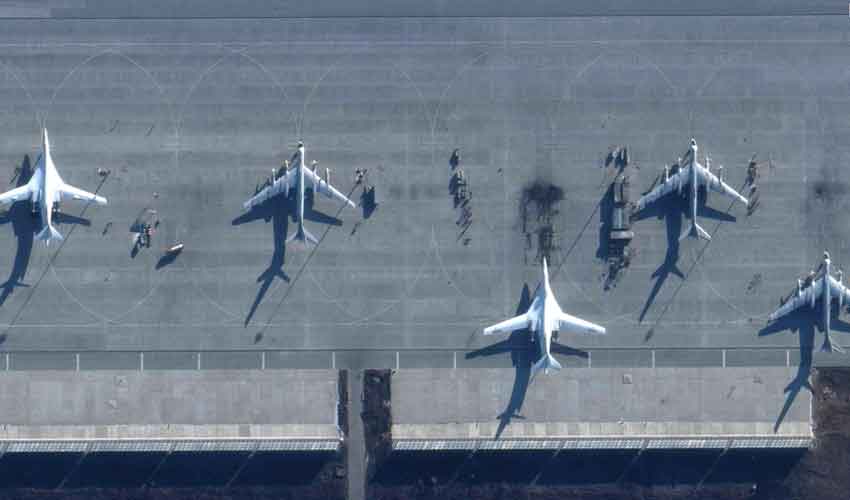Satellite imagery of a Russian air base, captured shortly after Ukraine conducted a deep drone attack inside Russia over the weekend, indicates that several strategic bombers were destroyed and severely damaged, according to assessments from three open-source analysts.
Ukraine targeted at least four air bases across Russia, deploying 117 unmanned aerial vehicles (UAVs) launched from containers positioned near the targets. Reuters verified drone footage of the operation, which shows multiple aircraft being struck at a minimum of two locations.
Capella Space, a satellite imaging company, provided Reuters with an image of one of these airfields, located in the Siberian region of Irkutsk. The image was taken on June 2, the day after one of the most sophisticated and effective operations launched by Ukraine in over three years of conflict.
While conventional satellite pictures can be obscured by cloud cover, the data utilized here comes from synthetic aperture radar (SAR) satellites. These satellites emit energy beams towards Earth and detect the echoes, enabling the identification of subtle topographical details.
The SAR image – which is grainier than standard high-resolution photographs and rendered in black and white – appears to show the wreckage of several aircraft positioned along the runway of the Belaya military air base or parked in protective revetments nearby.
“Based on the debris visible, comparison to recent satellite images and released drone footage from Telegram posted to Twitter, I can see the destruction of several aircraft,” stated John Ford, a research associate at the California-based James Martin Center for Nonproliferation Studies.
Ford indicated that the SAR imagery provided to him by Reuters revealed what seemed to be the remnants of two destroyed Tu-22 Backfires. These are long-range, supersonic strategic bombers that have been employed by Russia for missile strikes against Ukraine.
He added that both the SAR image and drone footage of the strikes shared on social media also suggested that four strategic Tu-95 heavy bombers had been either destroyed or significantly damaged.
Brady Africk, an open-source intelligence analyst, concurred that the SAR imagery of the Irkutsk air base showed multiple Tu-95s and Tu-22s had suffered destruction and damage. However, he noted that more imagery would be required for a complete assessment of the impact.
“But it is clear that the attack on this airbase was very successful,” Africk remarked.
“The aircraft targeted in the attack were a mix of Tu-22 and Tu-95 bombers, both of which Russia has used to launch strikes against Ukraine.”
Africk also pointed out that the Belaya air base houses several flat decoy aircraft, which, in this instance, apparently failed to mislead the Ukrainian drones.
Significant Explosion
Reuters has not yet obtained SAR imagery of the Olenya airfield, a base in Murmansk in Russia’s far northwest that was also reportedly attacked.
However, drone video footage of the Olenya base, provided by Ukrainian authorities and verified by Reuters, depicted two burning bombers, which appeared to be Tu-95s, and a third, also a Tu-95, being struck by a large explosion.
The Russian Defence Ministry stated that Ukraine had launched drone strikes targeting military airfields in the Murmansk, Irkutsk, Ivanovo, Ryazan, and Amur regions. While air defenses repelled the assaults in three regions, they were unsuccessful in Murmansk and Irkutsk, where several aircraft reportedly caught fire.
The Kremlin announced on Tuesday that Russia had initiated an official investigation into the Ukrainian drone attacks over the weekend.
Dmitry Medvedev, a prominent Russian security official, also commented on the strikes on Russian strategic bomber bases, indicating that Moscow would seek retribution. “Retribution is inevitable,” he stated.
Ukraine’s domestic security agency, the SBU, has claimed responsibility for the operation, named “Spider’s Web,” and asserted that a total of 41 Russian warplanes were hit.
Ukrainian President Volodymyr Zelenskiy lauded the attack, which struck targets up to 4,300 km (2,670 miles) from the frontlines of the war, as “absolutely brilliant.”
The Ukrainian military initially added 12 aircraft to its running tally of Russia’s wartime military losses on Tuesday.
“After processing additional information from various sources and verifying it… we report that the total (Russian) losses amounted to 41 military aircraft, including strategic bombers and other types of combat aircraft,” the SBU later updated. There was no immediate public response from Moscow to the SBU statement.
The SBU estimated the damage caused by the operation to be $7 billion and claimed that 34% of the strategic cruise missile carriers at Russia’s main airfields were impacted.
Reuters could not independently verify these claims.
Some experts suggested that while the operation might not halt Russia’s ability to launch missile attacks on Ukraine using strategic bombers, replacing the damaged planes would be exceedingly difficult, if not impossible, as some models are no longer in production.
According to the Institute for the Study of War (ISW) research group, the attack is also likely to compel Russia to reconfigure its air defenses.
“The… operation will force Russian officials to consider redistributing Russia’s air defence systems to cover a much wider range of territory and possibly deploying mobile air defence groups that can more quickly react to possible similar Ukrainian drone strikes in the future,” the ISW concluded.



